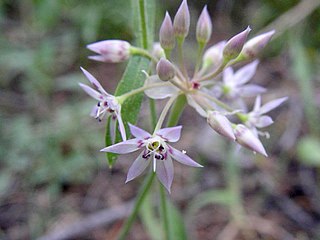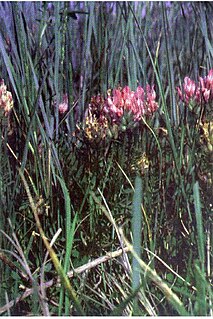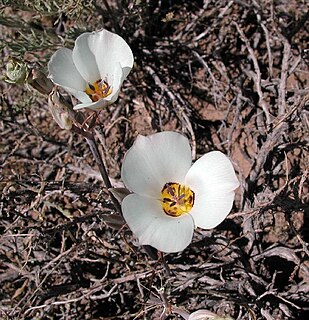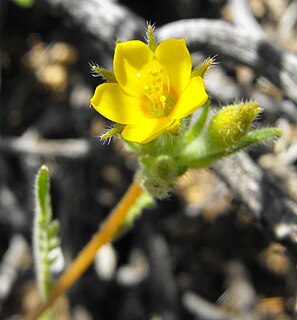
Allium campanulatum is a species of wild onion known by the common name dusky onion or Sierra onion. This is a flowering plant native to the western United States from southeastern Washington and northern Oregon to southern California, and western Nevada. The dusky onion grows in foothills and mountains, especially in dry areas, such as chaparral habitats.

Epilobium minutum is a species of willowherb known by the common names little willowherb, chaparral willowherb and desert willowherb. It is also called "smallflower willowherb" in reference to its small size relatively. However that name, in particular the British English variant "small-flowered willowherb", typically refers to Epilobium parviflorum.
Boechera cobrensis is a species of flowering plant in the mustard family known by the common names Masonic rockcress and sagebrush rockcress. It is native to the western United States from eastern California to Wyoming, where it is found in sandy habitat, especially sagebrush. This is a perennial herb growing several erect, slender stems to heights near half a meter from a branching caudex. The plant forms a narrow clump with a base of narrow, linear, densely hairy leaves up to 5 centimeters long. There are also a few slightly shorter leaves clasping the stems at intervals. The top of each stem is occupied by an inflorescence of small, nodding flowers with dull yellowish sepals and white petals. The flowers give way to fruits which are narrow, straight siliques up to 4 centimeters long containing winged seeds.

Astragalus agrestis is a species of milkvetch known by the common names purple milkvetch, purple loco, and field milkvetch. It is native to much of western and northern North America from most of Canada to the southwestern United States, as well as eastern Asia. It grows in vernally moist areas such as meadows, and is often found in sagebrush.

Astragalus bolanderi is a species of milkvetch known by the common name Bolander's milkvetch. It is native to western Nevada and parts of the Sierra Nevada in California. It grows in dry, rocky habitat on mountain and plateau.

Calochortus bruneaunis is a species of flowering plant in the lily family, and is known by the common name Bruneau mariposa lily.

Enceliopsis nudicaulis is a North American species of flowering plants in the daisy family known by the common name nakedstem sunray, or naked-stemmed daisy.

Mentzelia albicaulis is a species of flowering plants in the family Loasaceae known by the common names whitestem blazingstar, white-stemmed stickleaf, and small flowered blazing star. It is native to much of western North America, where it grows in mountain, desert, and plateau habitat.
Mentzelia montana, known by the common name variegated bract blazingstar, is a species of flowering plant in the family Loasaceae.

Pedicularis contorta is a species of flowering plant in the family Orobanchaceae known by the common names coiled lousewort and curved-beak lousewort. It is native to western North America, including southwestern Canada and the northwestern United States, where it grows in moist mountainous habitat, such as bogs, shady forests, and meadows. It is a perennial herb producing one or more stems up to 40 centimetres (16 in) tall from a caudex. The leaves are up to 18 centimetres (7.1 in) long, lance-shaped to oblong, and divided into many linear lobes which may be toothed or smooth-edged. The inflorescence is a raceme of flowers occupying the top of the stem. Each flower is a centimeter long or slightly longer, white to yellowish in color, and divided into a coiled or curved beak-like upper lip and a flat, three-lobed lower lip. The fruit is a capsule up to a centimeter long containing seeds with netted surfaces.
Psilocarphus elatior is a species of flowering plant in the aster family known by the common names tall woollyheads, meadow woollyheads and tall woolly-marbles. It is native to the Pacific Northwest in western North America from Vancouver Island, where it is known from just a few occurrences, to northern California. It grows in seasonally moist spots such as meadows, spring seeps, and vernal pools.

Pyrrocoma apargioides is a species of flowering plant in the aster family known by the common name alpineflames. It is native to the western United States from the Sierra Nevada of California east to Utah, where it grows in the forests and meadows of high mountains. It is a perennial herb growing from a taproot and producing one or more stems to 30 centimeters in length. The stems are decumbent or upright, reddish, and hairless to slightly woolly. Most of the leaves are located around the base. They are thick and leathery, lance-shaped with large sawteeth along the edges, often center-striped in white, and measure up to 10 centimeters long. The inflorescence is usually a single flower head lined with centimeter-long phyllaries which are reddish to green with red edges. The head has a center of yellow disc florets and a fringe of ray florets which are yellow, often splashed with red along the undersides, measuring up to 1.6 centimeters in length. The fruit is an achene which may be well over a centimeter in length including its pappus.

Stanleya pinnata is a species of flowering plant in the family Brassicaceae known as desert princesplume. It is native to North America.

Stellaria calycantha is a species of flowering plant in the family Caryophyllaceae known by the common name northern starwort. It is native to western North America from Alaska and northwestern Canada to California and New Mexico, as well as eastern Russia. It occurs in subalpine and alpine climates, in many types of moist, shady habitat. It is a rhizomatous perennial herb producing a prostrate to erect stem up to 25 centimeters long, taking a clumpy form. The thin oval leaves have smooth edges and pointed tips, and measure up to 2.5 centimeters in length. The inflorescence bears one or more flowers, each on a long pedicel. Each flower has five pointed green sepals, and some flowers have up to five deeply lobed white petals.

Stellaria nitens is a species of flowering plant in the family Caryophyllaceae known by the common names shiny chickweed and shining starwort. It is native to western North America, including British Columbia, Alberta, and the western United States, its distribution extending into Mexico at least as far as Baja California. It grows in many types of habitat, in dry and moist areas, and sometimes in disturbed places. It is an annual herb producing a slender, upright, four-angled stem from a thin taproot, reaching up to about 25 centimeters in height. Most of the leaves are located low on the stem, each measuring up to 1.5 centimeters long, with smaller, narrower leaves occurring above. The leaves are hairless except for some rough hairs along the margins, and the blades have shiny surfaces. The inflorescence bears a few flowers on short pedicels. The flower has five pointed sepals each a few millimeters long. There are sometimes five tiny white petals as well, though these are often absent.

Stylocline psilocarphoides is a species of flowering plant in the aster family known by the common names baretwig neststraw and Peck's neststraw. It is native to the western United States from Idaho to southeastern California, where it grows in deserts and other dry, sandy, gravelly habitat. It is a small annual herb growing at ground level with stems measuring 1 to 18 centimeters in length. It is woolly or felt-like in texture with a coating of white hairs. The pointed leaves are up to 1.8 centimeters long and alternately arranged. The inflorescence bears oval flower heads no more than half a centimeter in diameter. The head generally has no phyllaries, or has small ones that fall away early. It is a hardened ball of several woolly white flowers.
Frasera neglecta is a species of flowering plant in the gentian family known by the common name pine green gentian.

Trautvetteria is a genus of flowering plants in the buttercup family. Today it is often considered a monotypic genus, containing only one species, Trautvetteria caroliniensis, which is known by the common names Carolina bugbane, false bugbane, and tassel-rue. A second species, T. japonica, is now generally considered a variety of this species. The genus is named for the botanist Ernst Rudolf von Trautvetter.

Triteleia grandiflora is a species of flowering plant known by the common names largeflower triteleia, largeflower tripletlily and wild hyacinth. It is native to western North America from British Columbia to extreme northern California, eastward into Idaho, Montana and northern Utah, with disjunct populations occurring in Wyoming and Colorado. Its habitat includes grassland, sagebrush, woodlands, and forests. It is a perennial herb growing from a corm. It produces two or three basal leaves up to 70 centimeters long by one wide. The inflorescence arises on a smooth, erect stem up to 75 centimeters tall and bears an umbel-like cluster of many flowers. Each flower is a funnel-shaped bloom borne on a pedicel up to 4 or 5 centimeters long. The flower may be up to 3.5 centimeters long including the tubular throat and six tepals each just over a centimeter long. The inner set of three tepals are somewhat ruffled and broader than the outer tepals. The flower corolla may be deep blue to almost white with a darker blue mid-vein. There are six stamens with purple or yellow anthers.

Triteleia hyacinthina is a species of flowering plant known by the common names white brodiaea, white tripletlily, hyacinth brodiaea, and fool's onion. It is native to western North America from British Columbia to Idaho to central California. Its habitat includes grassland and vernally moist areas such as meadows and vernal pools. It is a perennial herb growing from a corm. It produces two or three basal leaves up to 40 centimeters (16 in) long by 2 centimeters (0.79 in) wide. The inflorescence arises on an erect stem up to 60 centimeters (24 in) tall and bears an umbel-like cluster of many flowers. Each flower is a funnel-shaped bloom borne on a pedicel up to 5 centimeters (2.0 in) long. The flower is white, often tinged purple along the tubular throat, with six green-veined tepals. There are six stamens with white, yellow, or occasionally blue anthers.
















